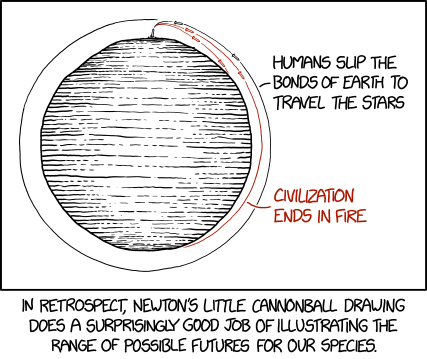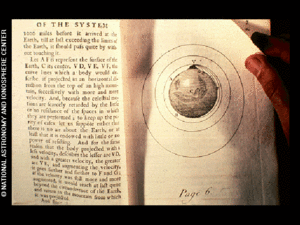2011: Newton's Trajectories
| Newton's Trajectories |
 Title text: With just one extra line, he could have anticipated the 2003 film The Core, but some things are too audacious for even the greatest visionaries. |
Explanation[edit]
The comic shows the Earth, with three apparent rockets on separate trajectories. One is released with sufficient velocity to attain a stable orbit, while the other two fall towards the Earth. This is a slight modification of Newton's cannonball, a thought experiment demonstrating the planetary effects of gravity.
The black rocket trajectory is typically that of a rocket delivering a payload to low earth orbit. While a satellite in orbit is still bound to earth, it represents an important step in the history of space exploration. Today, a lot of scientific research regarding the future of human spaceflight is done from low earth orbit, most notably on the ISS.
The red rocket trajectories are suborbital, and more commonly associated with ICBMs. These are missiles typically equipped with nuclear warheads. Using such a weapon is likely to trigger a global nuclear war, with disastrous effects for civilization. It is worth noting that ICBMs normally use a different trajectory that goes much higher before falling down at a steeper angle. These trajectories are also different from FOBS, where missiles actually go into orbit (the black trajectory) before deorbiting and falling back on earth.
Here, Newton's cannonball is used both to observe humanity’s technological future (interplanetary travel, availability of advanced technology to the masses, and constant scientific improvement; or nuclear desolation and the extinction of our species) and to underscore that argument by pointing out the inherent metaphor in the experiment: the cannonball can only escape the atmosphere by achieving high velocity (i.e. escape velocity). Similarly, Randall’s technological utopia will only deliver us from nuclear extinction if it happens quickly; otherwise, mankind will destroy itself. Of course, that threat only exists because of a triumph of technological progress, the Manhattan Project, but again, technology is a means to an end.
The phrase "slip the bonds of Earth" comes from the sonnet "High Flight" written in 1941 by John Gillespie Magee Jr., an American pilot in the Second World War. Portions of this poem appear on the headstones of many interred in Arlington National Cemetery, particularly aviators and astronauts; it was also quoted in President Reagan's speech after the Challenger disaster.
The title text alludes to the unfortunate film The Core, involving drilling to the center of the Earth to restart the stopped rotation of the magnetic core. The line is ostensibly aimed at the center of the Earth. Apparently, not even Newton could predict such a bold, daring and disastrous movie. Or movies.
Transcript[edit]
- [The panel shows a shaded sphere with a rocket launched from its top to the right. Several trajectories are plotted around the sphere.]
- [Trajectory 1 (in black) shows a successful circular orbit.]
- Humans slip the bonds of Earth to travel the stars
- [Trajectory 2 (in red) shows a ballistic arc that crashes into the sphere near the bottom.]
- Civilization ends in fire
- [Trajectory 3 (in red) shows a much shorter ballistic arc. No label.]
- [Caption below the panel:]
- In retrospect, Newton's little cannonball drawing does a surprisingly good job illustrating the range of possible futures of our species.
Discussion
Actually he's talking about ICBM's that have the potential to end civilisation in fire if actually launched, not the crash of a spaceship.141.101.107.156 04:39, 25 June 2018 (UTC) Agreed, the object emitted from the cannon is either a rocket or an ICBM. 172.69.158.46 04:51, 25 June 2018 (UTC)
Couldn't he be talking about the rocket being mistaken for whatever big bomb we use right now and start the whole mutually assured destruction gig? I hear that there have been a lot of close calls/radar malfunctions/whatever whatevers that almost sent us into the apocalypse. Come on, Didn't Germany write a song about that? (Granted, it's apparently the show of force that starts the war, but you guys get my point) 172.69.33.233 05:42, 25 June 2018 (UTC)
- I am German and didn't write a song on that issue. The song that comes closest for me is Fylingdale Flyer by Jethro Tull.
- Ninety-nine red balloons (https://en.wikipedia.org/wiki/99_Luftballons) by Nena - 108.162.219.148 08:02, 25 June 2018 (UTC)
- Neun Und Neunzig Luftballons, to say the title of the original German version in its native tongue.
- ProphetZarquon (talk) 17:54, 25 June 2018 (UTC)
I was surprised to see the quote 'slip the bonds of earth' on a circular orbit. This seems pretty bound to earth. Wouldn't it have made more sense to include a parabolic escape trajectory? --Quantum7 (talk) 10:01, 25 June 2018 (UTC)
- Except (as far as we know) Newton never considered parabolic trajectories. Whether he did or didn't, the original diagram didn't show anything beyond a circular orbit. Mr. I (talk) 12:36, 25 June 2018 (UTC)
- Maybe because the hard part is attaining a stable orbit. Once you do that, it's relatively trivial to escape it. Indeed even the orbit itself, while being determined by Earth, can be considered an escape since you will never again come back to Earth as long as that orbit is maintained. So Randall may have considered that close enough to talk about escaping the bonds of earth (which the stable orbit accomplished) and traveling to the stars (which is the logical next step; or at least to moons and planets so far in our case). -boB (talk) 15:03, 25 June 2018 (UTC)
When Jane's Defence discusses strategic (read: nuclear) weapons systems, they do not distinguish between satellite delivery vehicles and ICBM launch vehicles. The only differences are the trajectory and the payload. This comic is definitely about satellites and ICBMs. I'm new here, sorry if I'm not signing this properly --OtherBarry--
Fiery death is also mankinds's future if we remain passive and refrain from destroying ourselves, since the sun will eventually grow to engulf the earth. (Solar Evolution) So the comic is not necessarily as pessimistic as some may think. However, he leaves out the possibility of civilization ending in a non-fiery way before this event. 198.41.230.10 16:48, 25 June 2018 (UTC)
Note that for this comic the launch angle is near vertical and for all cases the object launched is steered in flight to the final trajectory. For Newton's canonball the ball was launched horizontal to the local Earth surface from a high mountain. A canonball launched vertically appears to be acted on by "forces" when seen from the Earth frame of reference. These "forces" depend on the launch site, altitude and velocity of the object - they are due to the rotating frame of reference. Baring atmospheric resistance, the only true forces on the ball after launch is gravity. But it is certainly true a ball fired vertically from anywhere but the poles does not land back at the site of launch due to the rotation of the Earth. For canon available in Newtons day corrections to aim were not necessary but by the late 1800's big guns were firing projectiles far and high enough that corrections for Coriolis forces were required. Corrections were pre-calculated for range and firing direction for whatever theater of war the gun was being used. 162.158.126.94 (talk) (please sign your comments with ~~~~)

